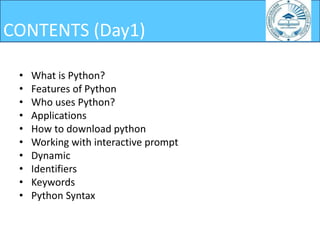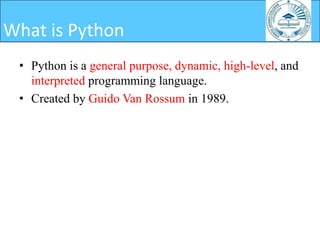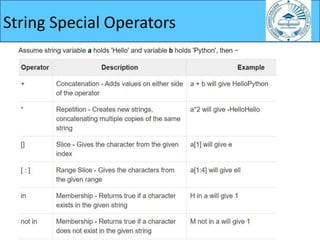Introduction to python
- 1. in CLOUD
- 2. • What is Python? • Features of Python • Who uses Python? • Applications • How to download python • Working with interactive prompt • Dynamic • Identifiers • Keywords • Python Syntax CONTENTS (Day1)
- 3. • Python is a general purpose, dynamic, high-level, and interpreted programming language. • Created by Guido Van Rossum in 1989. What is Python
- 4. 1) Easy to Learn and Use 2) Expressive Language 3) Interpreted Language 4) Cross-platform Language 5) Free and Open Source-https://www.python.org/ 6) Object-Oriented Language 7) Extensible 8) Large Standard Library 9) GUI Programming Support 10) Integrated Python Features
- 6. Applications
- 7. How to download Python
- 14. • When assigning to a variable, we do not need to declare the data type of the values it will hold. This is decided by the interpreter at runtime. • We do not declare a variable, we directly assign to it. Python is Dynamically-Typed
- 15. • A variable name is called an identifier and has to follow some rules: • Variables can have letters (A-Z and a-z), digits(0-9) and underscores. • It cannot begin with an underscore (_) or a digit. • It cannot have whitespace and signs like + and -, !, @, $, #, %. • It cannot be a reserved keyword for Python. • Variable names are case sensitive. Identifiers
- 16. • These are 33 reserved words. • You cannot use a word from this list as a name for your variable or function. • Python variable names are case-sensitive. The variable ‘name’ is different than the variable ‘Name’ Reserved Keywords
- 17. • The term syntax is referred to a set of rules and principles that describes the structure of a language. Python Syntax
- 18. A Python program comprises logical lines. A NEWLINE token follows each of those. The interpreter ignores blank lines. The following line causes an error. >>> print("Hi How are you?") Output: SyntaxError: EOL while scanning string literal Python Line Structure
- 19. • This one is an important Python syntax. • We saw that Python does not mandate semicolons. • A new line means a new statement. But sometimes, you may want to split a statement over two or more lines. Python Multiline Statements
- 20. • A docstring is a documentation string. • As a comment, this Python Syntax is used to explain code. • But unlike comments, they are more specific. Also, they are retained at runtime. This way, the programmer can inspect them at runtime. """ This function prints out a greeting """ print("Hi") Python Docstrings
- 21. • Python doesn’t use curly braces to delimit blocks of code, this Python Syntax is mandatory. • You can indent code under a function, loop, or class. • >>> if 2>1: print("2 is the bigger person"); print("But 1 is worthy too"); Python Indentation
- 22. You can also fit in more than one statement on one line. Do this by separating them with a semicolon. >>> a=7;print(a); Python Multiple Statements in One Line
- 23. Python supports the single quote and the double quote for string literals. But if you begin a string with a single quote, you must end it with a single quote. The same goes for double-quotes. • >>> print('We need a break'); • >>> print("We need a ‘break'"); Python Quotations
- 24. • You can use the % operator to format a string to contain text as well as values of identifiers. • Use %s where you want a value to appear. After the string, put a % operator and mention the identifiers in parameters. Python String Formatters I just printed 10 pages to the printer HP
- 26. • You can use the % operator to format a string to contain text as well as values of identifiers. • Use %s where you want a value to appear. After the string, put a % operator and mention the identifiers in parameters. Python String Formatters I just printed 10 pages to the printer HP
- 27. Python Syntax ‘Comments’ let you store tags at the right places in the code. You can use them to explain complex sections of code. The interpreter ignores comments. Declare a comment using an Hash(#). >>>#this is a comment line Python Comments
- 28. • Python allows us to assign a value to multiple variables in a single statement which is also known as multiple assignment. • We can apply multiple assignments in two ways either by assigning a single value to multiple variables or • assigning multiple values to multiple variables. Multiple Assignment
- 31. Anaconda
- 33. SPYDER
- 34. SPYDER
- 35. Python Data Types • Variables can hold values of different data types. • Python is a dynamically typed language hence we need not define the type of the variable while declaring it. • The interpreter implicitly binds the value with its type.
- 36. Python Data Types • python enables us to check the type of the variable used in the program. • Python provides us the type() function which returns the type of the variable passed.
- 37. Python Data Types Python data types are categorized into two as follows: Mutable Data Types: Data types in python where the value assigned to a variable can be changed Immutable Data Types: Data types in python where the value assigned to a variable cannot be changed
- 39. Python-Numbers • Number data types store numeric values. • They are immutable data types, means that changing the value of a number data type is not possible. • For example − • var1 = 1 var2 = 10 • You can also delete the reference to a number object by using the del statement. • Del var1
- 40. Python-Numbers • Python supports four different numerical types − • int (signed integers) − They are often called just integers or ints, are positive or negative whole numbers with no decimal point. • Long (long integers ) − Also called longs, they are integers of unlimited size, written like integers and followed by an uppercase or lowercase L. • float (floating point real values) − Also called floats, they represent real numbers and are written with a decimal point dividing the integer and fractional parts. • complex (complex numbers) − are of the form a + bJ, where a and b are floats and J (or j) represents the square root of -1 (which is an imaginary number).
- 41. Number Type Conversion • But sometimes, you need to convert a number explicitly from one type to another to satisfy the requirements of an operator or function parameter. • Type int(x) to convert x to a plain integer. • Type long(x) to convert x to a long integer. • Type float(x) to convert x to a floating-point number. • Type complex(x) to convert x to a complex number with real part x and imaginary part zero. • Type complex(x, y) to convert x and y to a complex number with real part x and imaginary part y. x and y are numeric expressions
- 43. Strings • Strings are amongst the most popular types in Python. • We can create them simply by enclosing characters in quotes. Python treats single quotes the same as double quotes. • var1 = 'Hello World!‘ • var2 = "Python Programming"
- 44. Accessing Values in Strings • Python does not support a character type; these are treated as strings of length one, thus also considered a substring. • To access substrings, use the square brackets for slicing along with the index or indices to obtain your substring.
- 45. Updating Strings • You can "update" an existing string by (re)assigning a variable to another string. The new value can be related to its previous value or to a completely different string altogether.
- 47. Strings
- 48. Python Lists • Lists are the most versatile of Python's compound data types. • A list contains items separated by commas and enclosed within square brackets ([]). • To some extent, lists are similar to arrays in C. • One difference between them is that all the items belonging to a list can be of different data type.
- 49. Python Lists
- 50. Python Tuples • A tuple is another sequence data type that is similar to the list. • A tuple consists of a number of values separated by commas. • Unlike lists, however, tuples are enclosed within parentheses. • The main differences between lists and tuples are: Lists are enclosed in brackets ( [ ] ) and their elements and size can be changed, • while tuples are enclosed in parentheses ( ( ) ) and cannot be updated. • Tuples can be thought of as read-only lists.
- 51. Python Tuples
- 52. Python Dictionary • A Python dictionary is a mapping of unique keys to values. Dictionaries are mutable, which means they can be changed. • Dictionaries are enclosed by curly braces ({ }) and values can be assigned and accessed using square braces ([]).
- 53. Python Dictionary dict = {'Name': 'Zara', 'Age': 7, 'Class': 'First'} Print( "dict['Name']: ", dict['Name']) print ("dict['Age']: ", dict['Age'])
- 54. Dictionary Functions • Len-The method len() gives the total length of the dictionary. • dict = {'Name': 'Zara', 'Age': 7}; • print (len(dict)) • Copy-The method copy() returns a shallow copy of the dictionary. • dict1 = {'Name': 'Zara', 'Age': 7}; • dict2 = dict1.copy() • print "New Dictionary : %s" % str(dict2)
- 56. • Keys-The method keys() returns a list of all the available keys in the dictionary. • my_dict = {'name':'Jack', 'age': 26} • print "Value : %s" % dict.keys() • Values-The method values() returns a list of all the values available in a given dictionary. • print "Value : %s" % dict.values()
- 58. Set in Python • A set is an unordered collection of items. • Every element is unique (no duplicates) and must be immutable (which cannot be changed). • my_set = {1, 2, 3} • print(my_set)
- 59. Change a set in Python • Sets are mutable. But since they are unordered, indexing have no meaning. • We can add single element using the add() method and multiple elements using the update() method. • The update() method can take tuples, lists, strings or other sets as its argument. In all cases, duplicates are avoided.
- 61. Remove elements from a set • A particular item can be removed from set using methods, discard() and remove(). • The only difference between the two is that, while using discard() if the item does not exist in the set, it remains unchanged. • But remove() will raise an error in such condition. • my_set.discard(4) • print(my_set) • my_set.remove(4)
- 62. Thank you
















































![Python Lists
• Lists are the most versatile of Python's compound
data types.
• A list contains items separated by commas and
enclosed within square brackets ([]).
• To some extent, lists are similar to arrays in C.
• One difference between them is that all the items
belonging to a list can be of different data type.](https://image.slidesharecdn.com/datatypes-211108033838/85/Introduction-to-python-48-320.jpg)

![Python Tuples
• A tuple is another sequence data type that is similar to
the list.
• A tuple consists of a number of values separated by
commas.
• Unlike lists, however, tuples are enclosed within
parentheses.
• The main differences between lists and tuples are: Lists
are enclosed in brackets ( [ ] ) and their elements and size
can be changed,
• while tuples are enclosed in parentheses ( ( ) ) and
cannot be updated.
• Tuples can be thought of as read-only lists.](https://image.slidesharecdn.com/datatypes-211108033838/85/Introduction-to-python-50-320.jpg)

![Python Dictionary
• A Python dictionary is a mapping of unique keys to
values. Dictionaries are mutable, which means they
can be changed.
• Dictionaries are enclosed by curly braces ({ }) and
values can be assigned and accessed using square
braces ([]).](https://image.slidesharecdn.com/datatypes-211108033838/85/Introduction-to-python-52-320.jpg)
![Python Dictionary
dict = {'Name': 'Zara', 'Age': 7, 'Class': 'First'}
Print( "dict['Name']: ", dict['Name'])
print ("dict['Age']: ", dict['Age'])](https://image.slidesharecdn.com/datatypes-211108033838/85/Introduction-to-python-53-320.jpg)








